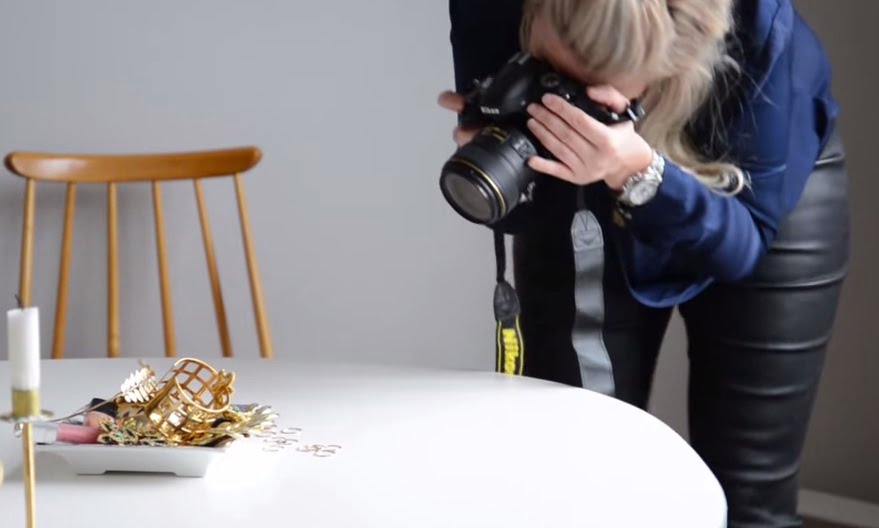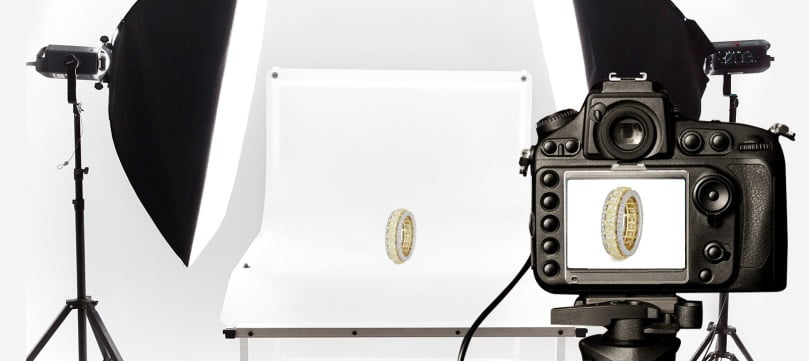When it comes to jewelry photography, plenty of online business owners get scared by how tiny, sparkly, and complicated the products can be. Heir smooth and shiny surfaces can cause chaotic reflections. Besides, their small sizes require high magnification, which can be a daunting task to achieve.
However, capturing jewelry products can be pretty more comfortable, thanks to the photo studio setup. Once you have your studio in place, now check out for these incredible tips on how to photography jewelry.

Get your props and materials ready.
The first and foremost thing to do is, gather all the materials and props for your jewelry photography session. You will need the following:
- Natural light coming through the window or artificial lighting
- Backdrops preferably white or black
- A good camera and a tripod stand
- Mannequin bust
- Cardboard
- Blu-tack, glue dots, or dual-sided tape
- String
Before you even think about the camera lens or other requirements, picking the right background for your jewelry is vital. It is responsible for making or destroying your final photo. Therefore, you need the best backdrop to give your product enhancements but should not overpower it.
So, consider the backdrop’s color, texture, shape, and see if it will suit your image styling. More importantly, be sure that your jewelry’s color and styling match the background you choose. Now that you have everything set, we move to the next step.
Step by Step Best Jewelry Photographic Process
-
Clean and polish your jewelry
The first and obvious thing to do is to make sure your jewelry items are clean and polished. There may be some dirt on your items that you may not see with a naked eye. But, the highly detailed images captured by your digital camera will indeed reflect the dirt, and you’ll get disappointed.
If your items don’t need any thorough cleaning, you can wipe to remove dust. After that, add polish to your jewels by tapping them using a soft, wet piece of cotton or microfiber cloth.
Additionally, put on cotton gloves on your hand to avoid leaving any fingerprints on the jewelry items while handling them. This will help you get crystal clear and attractive photos of your jewelry. If the images have dust after taking the photos you can choose our jewelry retouching service.
-
Use a quality camera with a Macro lens
Typically, there is a varied range of cameras. You can use a DSLR, Mirrorless camera, or your smartphone provided it has a powerful lens. The good thing with a DSLR camera is that you can use a macro lens kit and other extra features to give you a wide range of shooting. What’s more, choose a macro lens that fits your budget.
-
Use a robust tripod
Camera shake is often a photographer’s worst enemy. It results in blurry images with damaged quality. With small jewelry products, you will need something to hold the camera to get a better and precise shot. Therefore, a robust tripod stand with a detachable tripod ball head and adjustable height can be a great deal. By doing so, you can be sure to get still photos and from any angle you desire.
-
Light your jewelry well and evenly
A typical macro photography setup should have about two continuous lights or flash heads. Place one on the left and another one on the right-side of the jewelry. Most flash lighting setups found at web stores come in kits that contain all the essential accessories you need.
For instance, you will find them with a flash trigger to attach to your camera, diffusers, stands, and umbrellas. If you attach the reflective umbrellas with fabric diffusers to flash heads, any reflections from the camera disappear.
-
Focus with accuracy
The ultimate goal for jewelry photography is to highlight even the minute part of your item. It can be the diamonds or charms on a bracelet, and most people would rush for an AutoFocus. But, you can still get the focus not giving you the required close-ups.
Therefore, you need to check how perfect your AutoFocus was by reviewing the image. You can also zoom in to get a closer look, and if it’s not accurate, you can refocus, confirm, and lock it.
Also, ensure you have winning captions, and that every piece of jewelry is exact and in focus before ending your shooting. Besides, always capture several images of the same jewelry item to find the perfect one for your needs.
-
Modify your light setup
As a rule of thumb, natural light is the best lighting kit for any photography event. However, this can be best if there’s good light ideal for your items. If you want to get a more professional result, you’ll need artificial lights such as flashlights, LEDs, modifiers, and much more as per your desire. These units allow you to get a fully controlled lighting setup.
Regardless of the light you choose, the foremost important thing is to get clear and well-illuminated pieces for utmost attractiveness. Be sure to eliminate any shadows that would compromise your jewelry photo quality. If you like, add some lightboxes and reflectors to focus light on your jewelry items. It isn’t always good to mix different lighting kinds that can give various color temperatures.
-
Reduce reflections
Generally, jewelry items are still shiny and reflect too much light, significantly affecting the final photo quality. Removing reflections is a trial-and-error task. You can place a piece of paper around and at the camera, lens base to block reflections and bounce more light back towards your jewelry items.
Also, you can place a white piece of paper at the back and below your jewelry. Then put diffused overhead light on the sides to give adequate light without creating reflections. Use a tripod stand to raise your camera to a suitable angle for better results.
Final Words
Taking photos for your jewelry is pretty fun, and you don’t have to buy expensive accessories to get perfect images. With the above tips on photographing jewelry, nothing will stop you from achieving your jewelry business’s dream goals.
Most importantly, you will find it very affordable and time-effective to edit the final photos by yourself or professional editing companies like FixiPixi. We are reliable, punctual, and experts who have many years of experience in their field of work.


